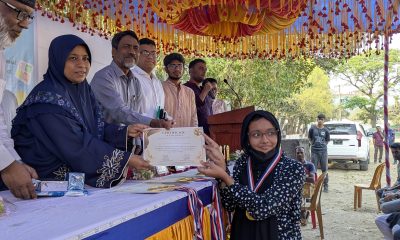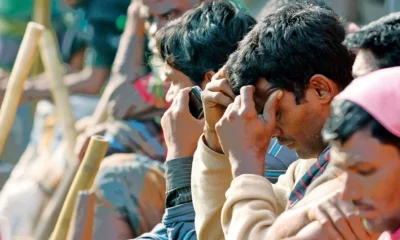Business & Finance
Wildlife on Taka: Bridging Nature and Currency

Could including indigenous wildlife on banknotes aid in bridging the divide between humans and nature as Bangladesh rethinks the design of its currency?
Since the beginning, denominations have served as a material representation of a nation’s identity. Coins and paper money frequently have images, slogans, and insignia. Beyond aesthetic considerations, however, this media is becoming more and more well-liked and incredibly successful in preserving human-wildlife relationships and promoting awareness of conservation in our quickly changing environment. A recent set of incidents got me thinking about how Bangladesh might gain from taking a similar tack.
I follow developments in the field of numismatics even if I’m not a serious coin and banknote collector. When the Republic of Abkhazia issued a 10 Asper banknote last year, my interest was piqued. I was particularly drawn to the banknote’s exquisite design, which included a gorgeously detailed Caucasian leopard on the back and vivid colours that ranged from chrome to ochre. This piqued my curiosity about international banknotes with carnivorous themes.
I soon discovered, though, that it was difficult to locate or compile a standard catalogue of these designs. The majority of currency studies concentrate on topics related to socioeconomic and political developments. My pals even recommended that I devote my time to more urgent conservation concerns. Then, coincidentally, I discovered an intriguing study that Griffith University researchers from Australia had published in People and Nature, a British Ecological Society publication, in July. I thought I had hit gold because it was the first research of its sort to examine banknote images of nature.
Examining 4,500 banknotes from 207 different countries, the researchers found that approximately one out of six of them depict native wildlife. Given that many of these species are endangered or restricted to particular regions, their significance is highlighted. With their diverse animal populations, tropical nations are the best illustrations of this trend. The survey found that the most often shown animals on banknotes from 1980 to 2017 were 195 bird species, 96 mammal species, insects, and reptiles.
Banknotes are effective messengers because they come into contact with millions of individuals every day. Featuring wildlife on banknotes can emphasise the need of conservation and act as a subliminal reminder of a country’s natural heritage. For example, the Jaguar on Brazilian banknotes and the Giant Panda on Chinese banknotes both symbolise national pride and conservation goals. Island nations such as the Bahamas emphasise swordfish and marlins as the species that draw tourists, bring in money, and have long been recognised as national symbols. One of the largest concentrations of denominations with a nature motif is found in Nepal, our neighbour.
The Oriental Magpie Robin and the Spotted Deer were originally featured on Bangladesh’s Taka notes. The deer was featured on One Taka notes until 1992, and the robin was featured on Two Taka notes until it was eliminated in 2018. Our circulating currency no longer features any wildlife. The Ministry of Finance and the Bangladesh Bank have agreed to revamp our Taka this October. Would the new designs feature elephants, tigers, fishing cats, or winter birds? Our delicate relationship with nature can be repaired by bringing wildlife closer to the general public.

Business & Finance
Climate Exodus: Struggles of Bangladeshi Migrant Workers

Every year, cyclones, tidal surges, and river erosion (climate) compel a large number of residents in Satkhira’s Shyamnagar upazila to abandon their houses close to the Sundarbans.
While some of them go to other regions of the nation, others sell their homes and land and take out loans in an attempt to make their fortune overseas. Many, however, become victims of forced climate labour and fraud and are forced to return home in much worse financial shape. Abdullah Rubel of the Padmapukur union in Shyamnagar is one such person. He used to work in a prawn enclosure to support his family. His business was destroyed by numerous natural disasters, which led him to seek wealth overseas.
He was unable to find employment in Brunei, which put him in an even worse position. With no other choice, he accepted a work in a Bangladeshi home in return for food and housing but without pay. He borrowed money, purchased a ticket, and left with the weight of debt and uncertainty after nine months of survival. He revealed to Prothom Alo that he lost everything after spending Tk 500,000 travelling overseas. He now works seasonal jobs to provide his family with bread and butter because he hasn’t paid back the mortgage and reclaimed his only source of income, the prawn enclosure.
Concerned citizens claim that sufferers of climate change are fleeing their homes in quest of financial security, not only from Satkhira but also from certain neighbouring districts. The increasing tendency of forced migration brought on by natural disasters was also highlighted by a recent study titled “Exposed and exploited: Climate change, migration, and modern slavery in Bangladesh.” The International Institute for Environment and Development (IIED) and the Ovibashi Karmi Unnayan Program (OKUP) carried out the study, which polled 648 families in 33 villages in the climate-affected areas of Gowainghat in Sylhet and Mathbaria in Pirojpur. According to the study, at least one member of 70.06 percent of families has moved.
According to the survey, migrants frequently feel powerless and are compelled to take any work since they are under pressure to pay back their loans. Others take on “inhumane” tasks because they want to provide for their families. They eventually become victims of contemporary slavery. The study discovered various elements of contemporary slavery in the instances it looked at, such as low or nonexistent pay, physical and psychological abuse, and limitations on mobility. Eighty-one percent went through five or more signs of modern slavery, and a startling 99 percent of workers had at least one experience of slavery. The average cost for Mathbaria migrants in Pirojpur to travel overseas was Tk 461,220. Of them, 18% took out high-interest loans, and 25% sold their land. <span;>Since 2022, the number of Bangladeshi workers leaving the nation has climbed dramatically, with over 100,000 workers leaving each month for two years in a row, according to the ministry of expatriates’ welfare and foreign employment. Even though the number decreased a little last year, about 80,000 workers still moved each month. Nevertheless, a large number of people return after being defrauded or unable to find employment overseas. With the exception of irregular migrants who are held overseas and then return home using an outpass or temporary travel permission, there is no official statistics on returnee migrants. Last year, more than 80,000 of these workers came home from overseas.
Hasan Gazi, a Shyamnagar resident, borrowed Tk 550,000 from family members in 2018 in order to travel to Kuwait through India. Floods destroyed his village home while he was away. He spent four years working in Kuwait before being arrested by the authorities and expelled. He told Prothom Alo that his family’s financial situation deteriorated as a result of the house being damaged by numerous floods and cyclones. They gained nothing by moving overseas. He now resides in a garage and runs an autorickshaw in Keraniganj. About 250 to 300 migrant workers return empty-handed every day, according to the BRAC migration program, which aids returning migrant workers. Many come in bad shape, broke, and even have trouble getting there.
Business & Finance
Unpaid for Eid: Tea Workers Struggle to Survive

Since she hasn’t received her paycheck for the last three months, widow Nazma Akhter, who works at the Kalagul Tea Garden in Sylhet, has been finding it difficult to provide for her family of six.
Nazma, the family’s only provider, has been compelled to take out loans and buy necessities on credit. She is currently in terrible shape, nevertheless, as a result of the mounting debt and the merchants’ refusal to provide her credit.
“I didn’t get an Eid bonus, and I haven’t been paid in three months. I was unable to purchase new clothing for my kids. On this day, our smiles are stolen,” Nazma remarked. She was echoed by Abdul Qadir, another tea garden employee. For the past three months, the families of at least 70 Muslim tea workers and about 400 Hindu workers in the garden have been living in poverty without their pay or rations. Bonuses for Eid were likewise not paid out.
Many families have been forced to the edge as a result, and there is now no obvious way to turn things around. “It is a daily struggle to ensure two handfuls of rice for all eight members of my family,” declared 45-year-old Fatema Begum, who works at Kalagul Tea Garden and is the family’s only pay earner. “While children from neighbouring tea gardens are enjoying the Eid festivities, mine are at home, disheartened, while I am still wondering how to feed them for the day,” she stated.
More than 2,500 workers from various tea gardens operated by Burjan Tea Company, including Burjan, Charagang, and Kalagul, are experiencing extreme financial difficulties, according to Raju Goala, organizing secretary of the Bangladesh Tea Workers’ Union. “The employees are having a hard time providing their families with food. They are owed over three months’ worth of unpaid salary, rations, and Eid bonuses by Burjan Tea Company. “The general manager of the company is not present during the protests by the workers,” he continued.
The company’s answer hasn’t been very encouraging thus far. Months have gone by and the workers are still not receiving their wages, despite their repeated promises that they would be paid shortly,” Goala said. “The company used to pay us weekly, but for the past 15 consecutive weeks, there has been no payment or rations,” stated Sohag Chhatri, a leader of the tea workers. We still haven’t gotten our festival bonuses for this year or last, and the company’s hospital is out of medication.” The workers have urged the authorities to step in and make sure the company pays their dues in letters to the Divisional Labour Office and the Sylhet deputy commissioner, but nothing has been done as of yet.
The Bangladesh Tea Workers’ Federation adviser, Sanjay Kanta Das, urged the government to step in and deal with the problem right away, stating that if it is not fixed quickly, the workers will be forced to take to the streets. When contacted, Burjan Tea Garden Company manager Md Kamruzzaman stated that the company has asked for a bank loan in order to cover the unpaid salary and rations. “The tea garden has been losing money and is currently dependent on bank loans to stay open. The arrears will be paid off as soon as we get the financing,” he continued.
Business & Finance
Bangladesh Gains Approval to Export Mangoes to China

According to the commerce ministry, Bangladesh has obtained permission to export mangoes to China after around six years of negotiations, and shipments are anticipated to start next summer.
To be exported to China, a food item needs to be registered with the General Administration of Customs of the People’s Republic of China (GACC). Mango approval was granted to Bangladesh in July of last year; jackfruit and guava approvals are still pending.
In addition to talks on exporting several other foods, like potatoes and fragrant rice, negotiations to obtain GACC registration for jackfruit and guava have just resumed. But there hasn’t been any noteworthy advancement. In 2019, Bangladesh submitted an application to sell mangoes and other agricultural goods to China. Such applications often take a long time to be decided by Chinese officials, and the Covid-19 outbreak made the process even longer. As a result, the decision to export mangoes took longer than six years.
Shafiqul Alam, the press secretary for the top adviser, stated at a news conference on March 20 that China has shown interest in buying guavas, jackfruits, and mangoes from Bangladesh. This interest was expressed by Chinese ambassador to Bangladesh Yao Wen in a recent meeting in Dhaka with chief adviser Professor Muhammad Yunus. “China is now eager to acquire guava, jackfruit, and mangoes from Bangladesh after the chief adviser made a request for them. It will lead to new export opportunities to China,” the press secretary said.
“The Chinese like the taste of our mangoes and jackfruits,” Mamun Mridha, a former general secretary of the Bangladesh-China Chamber of Commerce and Industry (BCCCI), told Prothom Alo. In the upcoming season, we intend to sell jackfruits as well as mangoes to China. It will increase over time as exports start. Additionally, the chance to earn foreign exchange will increase the commercial output of the crops. A group of Chinese businessmen reportedly traveled to Bangladesh last year to evaluate the possibility of importing jackfruit and mangoes. They visited Rajshahi to inspect orchards and offer advice on export packing requirements during their two-week stay. With funding from China, a mango testing facility is probably going to be established in the nation.
Foreign Secretary Jasim Uddin stated that the process of selling mangoes to China is nearing completion after a meeting with the Chinese ambassador in September. We requested market access for several products in the Chinese market as a sign of friendship. However, China authorizes each one separately. Chinese buyers have noticed that Bangladeshi potato prices are high because of production costs, according to trade ministry officials when questioned about exports of other goods to China. After examining a few samples, they discovered that the quality was below par.
Furthermore, the Chinese traders attributed the inconsistency of Bangladesh’s trade regulations to the impediment to the importation of fragrant rice. Exports of fragrant rice are periodically authorized and restricted by the trade ministry. India and Pakistan currently control the majority of China’s fragrant rice market. A visiting Chinese delegation has expressed a great preference for our mangoes and jackfruits, according to Anwar Hossain, vice chairman of the Export Promotion Bureau (EPB). “Efforts are being made to increase exports to include the additional products. We have hope,” he stated.
-

 Science & Environment1 week ago
Science & Environment1 week agoRESONANCE 1.0: Igniting Scientific Curiosity in Joypurhat
-

 Uncategorized5 months ago
Uncategorized5 months agoMindfulness
-

 Health & Lifestyle2 weeks ago
Health & Lifestyle2 weeks agoBangladesh Drops in Happiness Index 2025, Finland Tops Again
-

 Uncategorized7 months ago
Uncategorized7 months ago6 simple methods for doing pedicures at home.
-

 Health & Lifestyle3 weeks ago
Health & Lifestyle3 weeks agoTea After Iftar: Refreshing Tradition or Hidden Risk?
-

 Uncategorized8 months ago
Uncategorized8 months agoHow to be confident presentation in 10 ways
-

 Uncategorized8 months ago
Uncategorized8 months agoHow can you keep your relationship flawless and strong?
-

 Uncategorized8 months ago
Uncategorized8 months agoWhat colours of clothes should I wear according to our skin tone?

















